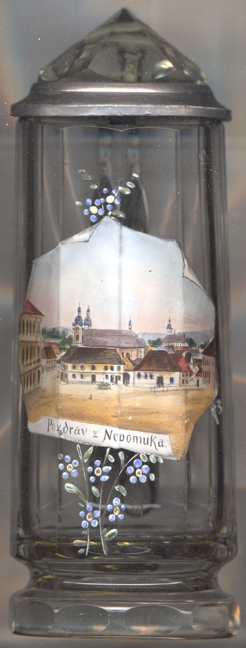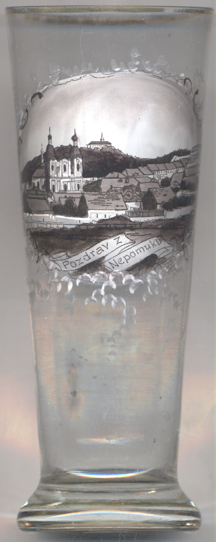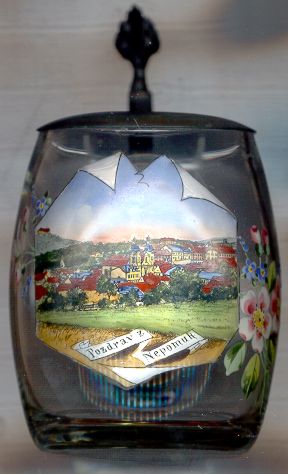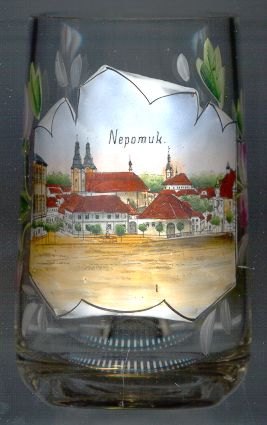

|
| ČESKÁ REPUBLIKA | CZECH REPUBLIC |
| Plzeňský kraj | Plzeň region |
| Okres: Plzeň-jih |

 Nepomuk developed at a crossing of important trading routes from Bohemia to Bavaria and Austria.
The original name of the town was Pomuk (first mentioned in a document of 1284), which was changed to Nepomuk after the villages of Pomuk and Přesanice were merged in 1384.
Nepomuk obtained the status of a town in 1413.
Nepomuk developed at a crossing of important trading routes from Bohemia to Bavaria and Austria.
The original name of the town was Pomuk (first mentioned in a document of 1284), which was changed to Nepomuk after the villages of Pomuk and Přesanice were merged in 1384.
Nepomuk obtained the status of a town in 1413.
 Nepomuk is famous as the birthplace of Saint John (of) Nepomuk (ca.1350–1393).
John studied theology at Prague and law at Padova. He became a notary in the offices of the Archbishops of Prague and later vicar general to the Archbishop.
He firmly insisted on the rights of the church against the crown, which made him very popular among the people but unpopular with King Wenceslav (Václáv, Wenzel) IV of Bohemia (also German King).
According to the legend John became the confessor of the Queen, but refused to breach the confessional secret (this version was declared false in 1961).
It is, however, a fact that the King ordered him to be tortured and then drowned in the river Vltava (Moldau) in Prague in 1393.
His body was found by a miracle: one version says that the river ran dry, another version tells that the Queen had an apparition of five stars (which later became one of the
popular attributes of the Saint). He was buried in the cathedral of Prague. A statue of John Nepomuk was erected on the Charles bridge in Prague in 1693 (he later also
became a patron saint of bridges and river crossings). It is said that when his grave was opened in 1719 his tongue was found miraculously well preserved.
He was canonized by Pope Benedict XIII in 1729, his feast day is the 16th of May. He is the patron saint of Bohemia.
Nepomuk is famous as the birthplace of Saint John (of) Nepomuk (ca.1350–1393).
John studied theology at Prague and law at Padova. He became a notary in the offices of the Archbishops of Prague and later vicar general to the Archbishop.
He firmly insisted on the rights of the church against the crown, which made him very popular among the people but unpopular with King Wenceslav (Václáv, Wenzel) IV of Bohemia (also German King).
According to the legend John became the confessor of the Queen, but refused to breach the confessional secret (this version was declared false in 1961).
It is, however, a fact that the King ordered him to be tortured and then drowned in the river Vltava (Moldau) in Prague in 1393.
His body was found by a miracle: one version says that the river ran dry, another version tells that the Queen had an apparition of five stars (which later became one of the
popular attributes of the Saint). He was buried in the cathedral of Prague. A statue of John Nepomuk was erected on the Charles bridge in Prague in 1693 (he later also
became a patron saint of bridges and river crossings). It is said that when his grave was opened in 1719 his tongue was found miraculously well preserved.
He was canonized by Pope Benedict XIII in 1729, his feast day is the 16th of May. He is the patron saint of Bohemia.

The  pilgrimage church of St. John of Nepomuk (kostel svatého Jana Nepomuckého)
[far left, no. 4111, and near left, no. 1036: background centre; and right, no. 1159: centre left]
was built by the famous architect Kilian Ignaz Dientzenhofer in 1734–1736 in splendid Baroque style in place of an older chapel of St. John the Baptist.
pilgrimage church of St. John of Nepomuk (kostel svatého Jana Nepomuckého)
[far left, no. 4111, and near left, no. 1036: background centre; and right, no. 1159: centre left]
was built by the famous architect Kilian Ignaz Dientzenhofer in 1734–1736 in splendid Baroque style in place of an older chapel of St. John the Baptist.
The  church of St. James (kostel svatého Jakuba) [near right, no. 1159: background right]
was built in Gothic style in 1290–1295 in place of an older church of the 12th century. Parts of the church were altered in Baroque style in the late 18th century.
church of St. James (kostel svatého Jakuba) [near right, no. 1159: background right]
was built in Gothic style in 1290–1295 in place of an older church of the 12th century. Parts of the church were altered in Baroque style in the late 18th century.
 Zelená hora castle [far right, no. 3481: far background]
is located about 1 km north of Nepomuk on top of the mountain Zelená hora ('Green mountain', 536 m)
in the municipality Klášter. The castle was first mentioned in 1221. This first castle apparently did not
survive for long. Another fortress was built here by the Hussites in 1419, followed by a castle in 1454 built by the
lord of Schwanberg (Švamberk). In 1465 it was here that 16 important Bohemian noble families signed an alliance
against King George of Poděbrady. Two years later, the castle was the site of a further treaty between the alliance
and Emperor Friedrich III with the purpose of deposing King George. Since 1558 the castle was in possesson of the
lords of Sternberg (Šternberk), followed in 1726 by the Martinic and in 1784 by the
Colloredo-Mansfeld. In 1817 two pages of an old document were 'discovered' in the archives, which were for long thought
to be documents in Old Czech language from the 8th or 9th century. It was only agreed in 1886/1887 that this so-called
Zelená hora document, together with the 'Dvůr Králové nad Labem document',
were actually falsifications (a scientific proof was found in 1967). The castle was devastated in 1939 by the German Wehrmacht,
followed by lootings after the war. Until 1990 it served as military barracks. Since 1992 the castle is in possession of the
municipality Klášter.
Zelená hora castle [far right, no. 3481: far background]
is located about 1 km north of Nepomuk on top of the mountain Zelená hora ('Green mountain', 536 m)
in the municipality Klášter. The castle was first mentioned in 1221. This first castle apparently did not
survive for long. Another fortress was built here by the Hussites in 1419, followed by a castle in 1454 built by the
lord of Schwanberg (Švamberk). In 1465 it was here that 16 important Bohemian noble families signed an alliance
against King George of Poděbrady. Two years later, the castle was the site of a further treaty between the alliance
and Emperor Friedrich III with the purpose of deposing King George. Since 1558 the castle was in possesson of the
lords of Sternberg (Šternberk), followed in 1726 by the Martinic and in 1784 by the
Colloredo-Mansfeld. In 1817 two pages of an old document were 'discovered' in the archives, which were for long thought
to be documents in Old Czech language from the 8th or 9th century. It was only agreed in 1886/1887 that this so-called
Zelená hora document, together with the 'Dvůr Králové nad Labem document',
were actually falsifications (a scientific proof was found in 1967). The castle was devastated in 1939 by the German Wehrmacht,
followed by lootings after the war. Until 1990 it served as military barracks. Since 1992 the castle is in possession of the
municipality Klášter.
[https://de.wikipedia.org/wiki/Schloss_Zelená_Hora]
![[scale]](lineal.jpg)